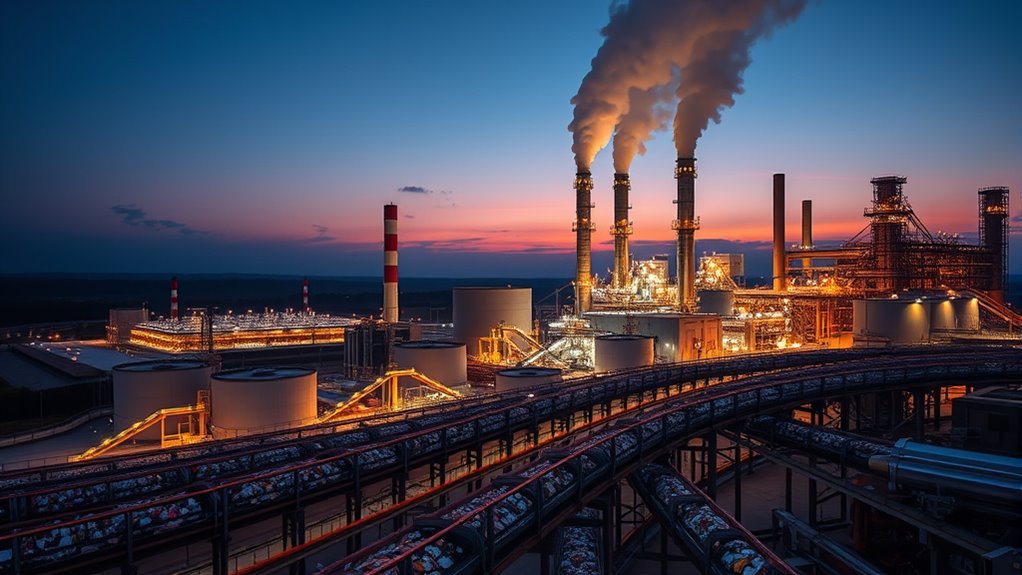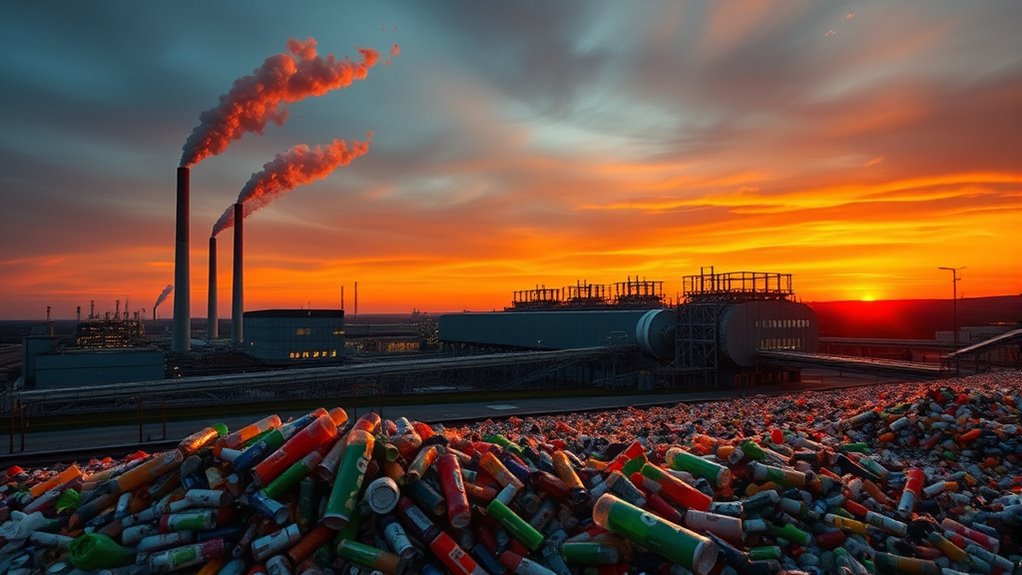Waste-to-energy (WTE) technology offers a promising way to turn trash into valuable fuel and energy, helping you reduce waste and cut greenhouse gases. Modern plants use advanced methods like gasification and pyrolysis to efficiently extract power while controlling emissions. They are cleaner and safer than traditional landfills and open burning. By embracing WTE, you can support sustainable waste management and a greener future—discover how this innovative solution is transforming trash into a renewable resource.
Key Takeaways
- Waste-to-energy (WTE) technology converts municipal waste into electricity or heat, reducing landfill use and fossil fuel dependence.
- Advanced thermal processes like gasification and pyrolysis extract more energy with fewer emissions.
- Pollution control devices ensure cleaner emissions, making WTE a more environmentally friendly waste management option.
- Digital monitoring and automation optimize plant efficiency and safety while maximizing energy recovery.
- WTE supports sustainable development by transforming waste into renewable energy, contributing to a circular economy.

Have you ever wondered how waste can be turned into a valuable resource? It’s a fascinating process that’s gaining momentum as communities look for sustainable solutions to manage their trash. Waste-to-energy (WTE) technology transforms municipal solid waste into electricity or heat, addressing waste disposal issues while reducing reliance on fossil fuels. This approach not only helps manage overflowing landfills but also offers a cleaner way to generate power, making it an increasingly attractive option worldwide. The environmental impact of traditional waste disposal methods, like landfilling and open burning, can be severe, causing soil and water contamination and releasing harmful greenhouse gases. WTE technology, however, aims to mitigate these issues by capturing the energy from waste in a controlled environment, *substantially* reducing emissions compared to conventional methods. This shift is made possible through technological advancements that have improved the efficiency and safety of waste-to-energy systems. Modern incineration plants now incorporate sophisticated pollution control devices, such as filters and scrubbers, which trap pollutants before they can escape into the atmosphere. These innovations have helped address longstanding concerns about air quality and environmental health, making WTE a more viable and responsible energy solution. As technology continues to evolve, so does the ability to process diverse waste streams, including plastics, organic matter, and other non-recyclable materials. Advanced thermal conversion methods like gasification and pyrolysis are now capable of extracting even more energy from waste with fewer emissions, broadening the potential of WTE plants. These improvements not only increase energy recovery rates but also reduce the carbon footprint associated with waste management. *furthermore*, the integration of digital monitoring and automation has enhanced operational safety and efficiency, allowing plants to optimize energy output while minimizing environmental impacts. Additionally, the growing use of renewable energy principles in WTE design helps ensure that the environmental benefits are maximized. The promise of waste-to-energy technology lies in its potential to turn what was once considered useless trash into a sustainable resource, contributing to a circular economy. By converting waste into electricity or fuel, communities can reduce their dependence on fossil fuels, lower greenhouse gas emissions, and promote cleaner air and water. As public awareness grows and technological advancements continue, WTE plants are becoming a more mainstream solution for sustainable waste management and energy production. While challenges remain, such as public acceptance and high initial costs, the benefits of reducing environmental impact and harnessing innovative technology make waste-to-energy a promising part of our future energy landscape. It’s an exciting time to see how our waste can be transformed from a problem into a solution, powering our lives while protecting the planet.
Frequently Asked Questions
What Types of Waste Can Waste-To-Energy Systems Process?
You can use waste-to-energy systems to process various waste types, including municipal solid waste, industrial waste, and some hazardous materials. These systems efficiently convert waste into energy, reducing landfill volume and environmental impact. However, hazardous materials require special handling and treatment to guarantee safety. By processing these wastes, you help lower pollution and generate renewable energy, making waste-to-energy a valuable technology in waste management and sustainability efforts.
How Much Energy Can a Typical Waste-To-Energy Plant Generate?
Imagine turning waste volume into power—waste-to-energy plants do just that through energy conversion. Typically, they generate between 15 to 30 megawatts of electricity, enough to power thousands of homes. The amount depends on waste volume and composition. So, by burning trash efficiently, you can produce significant energy, reducing landfill overflow while supplying clean power, making it a smart solution for sustainable energy needs.
What Are the Environmental Impacts of Waste-To-Energy Technology?
You might wonder about waste-to-energy‘s environmental impacts. While it reduces landfill waste and generates energy, it can also cause air pollution from emissions like dioxins and particulates. Additionally, it releases greenhouse gases, though typically less than landfilling. It’s important to weigh these impacts, as proper technology and regulation can minimize air pollution and greenhouse gases, making waste-to-energy a more sustainable option.
How Do Waste-To-Energy Plants Compare Economically With Recycling?
You might be surprised to learn that waste-to-energy plants can be more cost-effective than recycling in some cases. A recent cost analysis shows that waste-to-energy can generate revenue from energy sales, boosting market competitiveness. While recycling often costs less upfront, waste-to-energy offers a consistent waste management solution and energy production, making it a compelling economic option. Your choice depends on local priorities and long-term sustainability goals.
Are Waste-To-Energy Facilities Safe for Nearby Communities?
You might wonder if waste-to-energy facilities are safe for your community. Generally, they are designed with strict safety standards to protect community health, but concerns like noise pollution and emissions can still arise. Proper siting, advanced filtration, and noise controls help minimize risks. While they’re safe when well-managed, it’s important to stay informed and advocate for ongoing monitoring to guarantee your community remains healthy and quiet.
Conclusion
By embracing waste-to-energy technology, you hold the power to turn trash into treasure, transforming environmental challenges into sustainable solutions. Imagine a future where your waste fuels progress rather than pollutes—it’s a beacon of hope shining through the darkness of pollution. Don’t let waste be just waste; see it as an opportunity waiting to be accessed. Together, you can ignite a cleaner, greener world, proving that even trash can become a catalyst for change.









